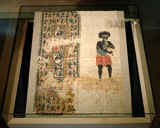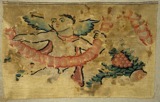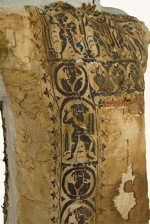Tapestry
hanging
Inv. No. 7948
Linen, wool
L: 142 cm, W: 103 cm
Antinoë (?), 4th/ 5th century
The Copts were famous for their outstanding weaving skills
and exported their products to other Mediterranean
countries. The textiles were mainly made of plain linen in
which the entire surface was decorated with dyed woolen
threads. This technique is called tapestry. One of the
finest examples was probably used as a curtain and is
decorated with a dark-skinned piper (on the right) and
figures of dancers, warriors and men on horseback in Greek
style (on the left). Such fragments of tapestry even give a
vivid picture of Coptic taste.
Tapestry
hanging
Inv. No. 7690
Linen, wool
Bought from Kamel Abdallah Hammouda, 4th century
In this tapestry, a winged erote is holding a garland. The
lower right corner of this tapestry is decorated with
leaves and bunches of grapes. Black was used for the
outlines of the figures and different shades of the same
color from blue to grey along with different reds give this
piece a special optical effect. Such tapestry hangings
furnished the houses of wealthy Copts and were either hung
on walls or used as curtains.
Piece of
textile
Inv. No. 7645
Linen, wool
Bought from Ashirof, 6th-8th century
This piece of textile is woven in tapestry with woolen
threads ornamented with human figures, animals, floral
designs and birds.
Fragment
of tapestry with squares and interlace
Inv. No. 4783
Linen and wool
H: 30 cm, W: 31 cm
Unknown provenance, 4th century
Textiles like this example produced in the 4th and 6th
centuries were mainly monochromatic (use of only one color)
and decorated with intricate geometric and interlace
design. Violet was one of the prefered colors with which
the woolen threads were dyed.
Tunic
Inv. No. 10605
Linen, wool
Unknown provenance, 5th-6th century
This tunic was a garment commonly worn by males in
Greco-Roman civilizations. At the top of this tunic, an
arcade encloses figures of dancers and warriors. Below, two
vertical panels with warriors and dancers alternate with
roundels amid human busts.
Fragment of
tapestry
Inv. No. 1708
Linen, wool
Unknown provenance, 7th / 8th century
A tapestry roundel with woollen and linen threads is
decorated with two standing figures with haloes flanking a
rod.
Fragment of
tapestry
Inv. No. 1896
Linen, wool
Unknown provenance, 5th century
A roundel in tapestry with woollen and linen threads. In
the middle are geometrical designs surrounded by fruit
baskets and turtles.






